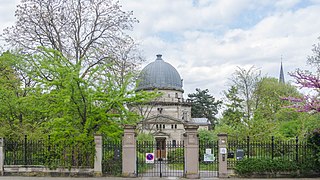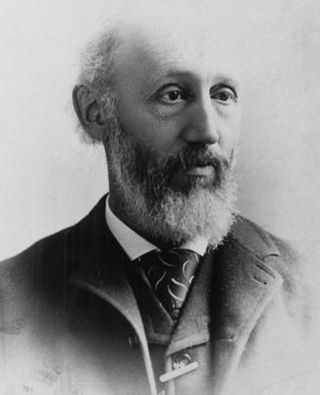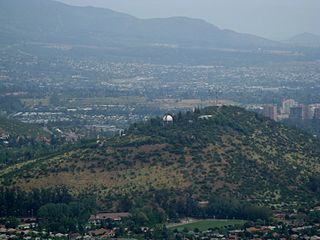
Radio astronomy is a subfield of astronomy that studies celestial objects at radio frequencies. The first detection of radio waves from an astronomical object was in 1933, when Karl Jansky at Bell Telephone Laboratories reported radiation coming from the Milky Way. Subsequent observations have identified a number of different sources of radio emission. These include stars and galaxies, as well as entirely new classes of objects, such as radio galaxies, quasars, pulsars, and masers. The discovery of the cosmic microwave background radiation, regarded as evidence for the Big Bang theory, was made through radio astronomy.

The Observatory of Strasbourg is an astronomical observatory in Strasbourg, France.

The Astronomical Journal is a peer-reviewed monthly scientific journal owned by the American Astronomical Society (AAS) and currently published by IOP Publishing. It is one of the premier journals for astronomy in the world.
Frank Washington Very was a U.S. astronomer, astrophysicist, and meteorologist. He was born in Salem, Massachusetts, and educated at Massachusetts Institute of Technology (1873) where he taught physics after his graduation.

Benjamin Apthorp Gould was a pioneering American astronomer. He is noted for creating the Astronomical Journal, discovering the Gould Belt, and for founding of the Argentine National Observatory and the Argentine National Weather Service.

Lewis Boss was an American astronomer. He served as the director of the Dudley Observatory in Schenectady, New York.
King School, formerly King Low Heywood Thomas, is a private day school for pre-kindergarten through grade 12 in Stamford, Connecticut, United States. King attracts students from 30 towns in the Fairfield County, Connecticut and Westchester County, New York areas. It operates as a 501c(3) non-profit institution and serves approximately 700 students.

George Washington Hough was an American astronomer.

The Detroit Observatory is located on the corner of Observatory and Ann streets in Ann Arbor, Michigan. It was built in 1854, and was the first scientific research facility at the University of Michigan and one of the oldest observatories of its type in the nation. It was designated a Michigan State Historic Site in 1958 and placed on the National Register of Historic Places in 1973.
The Museum of Innovation and Science is a museum and planetarium located in Schenectady, New York. miSci was founded in 1934 and its exhibitions and educational programming focus on Science, Technology, Engineering, Art, and Mathematics (STEAM). As of September 2023, the museum's president is Gina C. Gould, PhD; Vice President of Collections and Exhibitions is Chris Hunter; and Director of Grants and Special Events is Peter Gabak.
Benjamin Boss was an American astronomer. He served as the director of both the Dudley Observatory in Schenectady, New York and the Department of Meridian Astrometry of the Carnegie Institution of Washington.

Astronomy & Astrophysics (A&A) is a monthly peer-reviewed scientific journal covering theoretical, observational, and instrumental astronomy and astrophysics. It is operated by an editorial team under the supervision of a board of directors representing 27 sponsoring countries plus a representative of the European Southern Observatory. The journal is published by EDP Sciences and the current editors-in-chief are Thierry Forveille and João Alves.

The area of New York's Capital District, also known as the Albany metropolitan area, has seen prominent historical events, artistic creations, and unique contributions to the culture of the United States since the 17th century. The largest city in the area, Albany, consistently ranks high on lists of top cities/metro areas for culture, such as being 23rd in the book Cities Ranked & Rated. The Albany-Schenectady-Troy metro area ranked 12th among large metro areas, and Glens Falls ranked 12th among the small metro areas, in Sperling's Best Places, and Expansion Management gave the Albany-Schenectady-Troy area five Stars, its highest ranking, for quality of life features.

The National Astronomical Observatory of Chile is an astronomical observatory owned and operated by the Department of Astronomy of the University of Chile (UCh). It is located on Cerro Calán, a hill in the commune of Las Condes. The commune is an eastern suburb of Santiago located in Santiago Province of the Santiago Metropolitan Region. OAN was founded in 1852 and became a part of UCh in 1927. The facility on Cerro Calán was completed in 1962.
Helaine Selin is an American librarian, historian of science, author and book editor.

The Alton Museum of History and Art, sometimes known as the Robert Wadlow Museum, in Alton, Illinois was founded in 1971 as a not for profit organization. It is located in Loomis Hall, named for Rev. Hubbel Loomis, on the grounds of the former Rock Spring Alton Baptist Seminary established by missionary John Mason Peck, later renamed Shurtleff College, and presently the home of the Southern Illinois University School of Dental Medicine. The building, which has Underground Railroad history, was constructed as the original chapel/classroom of the seminary c.1820 and the sanctuary was modified in the early 1900s to be a two-story building with a rear classroom and laboratory addition. The building is the state's second oldest remaining college building.
Isis Pogson,, was a British astronomer and meteorologist who was one of the first women to be elected as a fellow of the Royal Astronomical Society.

The Digital Place-based Advertising Association (DPAA) is a trade organization based out of Cutchogue, New York that is focused on digital place-based advertising. It is listed as a 501(c)(6) non-profit by the IRS. The DPAA was established in 2007 and was initially known as the Out-of-Home Video Advertising Bureau (OVAB). In 2010, the association was rebranded as the DPAA, and its scope expanded to provide industry-related support to its members, suppliers, and professionals involved in digital out-of-home networks.

Artisans Asylum is a non-profit community workshop in Allston, Massachusetts. Artisans Asylum was founded in 2010 by an engineer, an artist, and friends. Artisans was the first makerspace to incorporate in the U.S. in 2012. Today, it holds 52,000 square feet of fabrication space between two buildings.
May Arif Kaftan-Kassim, also known as May A. Kaftan, was an Iraqi radio astronomer. She trained at Harvard University, and advised on the creation of the Erbil Observatory in Iraq in the 1970s.















